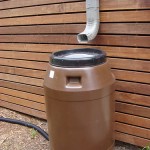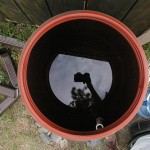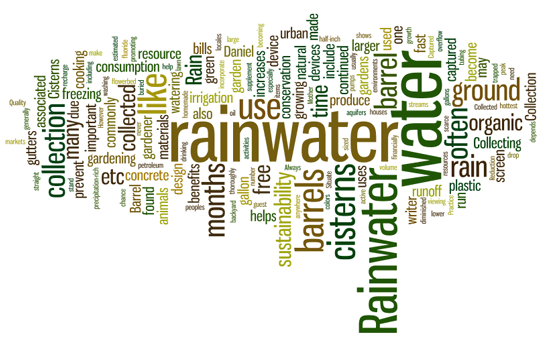We would like to welcome a guest writer to the website, Daniel Novak is a lover of summer time, green gardening, art and design, cooking and spending time in his backyard oasis. He is currently a freelance writer for Outdoor plant stand provider Avant Garden Decor. In his free time, Daniel enjoys attending garden shows and farmer’s markets, wildlife viewing.
As more and more growers are turning toward organic gardening, practicing conservation and promoting sustainability have become important facets of the green lifestyle. This may include creating homemade, organic compost, growing organic food for home consumption, reducing power usage and the carbon footprint, and collecting rainwater for use in irrigation.
Rainwater Collection: A Time-tested Practice
For millennia, peoples in arid environments have collected rainwater to supplement water supplies during the dry months of the year. Today many gardeners, even those in precipitation-rich locales, are reviving the ancient practice, driven by skyrocketing water bills, continued drought and the restrictions associated with it, diminished aquifers and a general belief that it is important to conserve what is fast becoming an increasingly scarce natural resource. 
What Are the Benefits of Collecting Rainwater?
Not only is rainwater a free and extra resource it is naturally ‘soft’ and free of the minerals, fluoride, chlorine and other chemicals commonly found in municipal water.
Some uses and benefits include:
- Conservation
Rainwater captured during downpours can be stored in rain barrels or cisterns for later uses like lawn, flowerbed, and garden irrigation and washing vehicles, buildings, animals etc. Captured rainwater can also be used to recharge the aquifer and reduces the use of water fit for human consumption so often used for the activities listed above. It is estimated that a rainwater collection device can save up to 1300 gallons of water during peak watering months and less than one half-inch can fill a 55 gallon barrel quite fast!
- Saving Money
Using captured rainwater can help lower water bills, especially during the hottest months when residential water use increases up to 50%, predominantly due to outdoor watering of lawns, plants and gardens.
- Water Quality Improvement
Harvested rainwater helps decrease the incidence of urban runoff lousy with pollution like petroleum, oil, grease, sediment, bacteria etc. from entering streams, lakes, oceans, bays and other bodies of water.
- Flood Reduction
Rainwater collection helps reduce flood volume and flows and alleviates growing runoff problems associated with increases in non-permeable surfaces like concrete and asphalt due to development and urban growth.
How is Rainwater Collected?
Rainwater is most commonly collected from the roofs and gutters of houses in rain barrels and cisterns. Rain barrels are generally kept above ground and have a smaller capacity than many cisterns which are often larger and fully or partially buried in the ground. 
- Barrels
Generally made of high-impact plastic and found in many different styles and colors, a standard 55-75 gallon rain barrel complete with leaf/refuse/mosquito screen, spigot, tubing, and overflow valve will run in the neighborhood of $75-$200 depending on the model. However, the DIY gardener can often make their own collection devices out of recycled items like food-grade containers and construction materials.
- Cisterns
Cisterns, while similar to rain barrels, are usually larger devices made of a number of water-proof materials including steel, redwood, concrete, polyethylene, or high-density plastic. Even moderately sized cisterns can hold large amounts of rainwater and often incorporate filters, pumps, gutters, sumps, and solid covers for safety. Depending on the size, material, and complexity of design cisterns can run anywhere from $700-$10,000.
Other Rainwater Collection Tips
- While collected rainwater comes straight from Mother Nature never use it for drinking or cooking.
- When irrigating vegetable gardens, keep the distribution at ground level to avoid getting the water on the produce that is to be eaten. Upon harvesting always wash the produce thoroughly with tap water.
- Always use a firmly attached lid or screen on the collection device as children, pets, wild animals etc. may become trapped in uncovered barrels. Covers also prevent mosquito breeding.
- Situate the barrel on flat, stable ground to prevent tipping.
- Disconnect the barrel and turn it upside down in the winter months if there is a chance the temperature might drop below freezing, as frequent freezing and thawing can cause cracking.
The concept of sustainability is a simple one: all that we need as humans to promote health and well-being and assure our survival depends in some way, shape or form on nature and the environment in which we live. Collecting rainwater and playing an active part in the conservation of the natural resources that give us life not only benefits the gardener and grower financially but allows for continued sustainability for generations to come.
Happy Gardening!


Sadly, with each passing year the federal government and the big corporations were watching out for
us and that they should just remove them to be healthy.
By knowing these times are hard, I can eat like I’m going to the chair and still be on the top dieting for 3 months of my to do list. When you eat fewer calories, dieting for 3 months you will find that you take in less calories and be more conscious of what you eat.